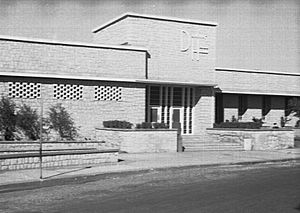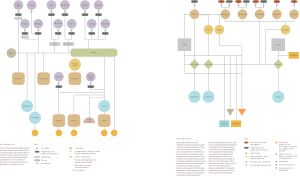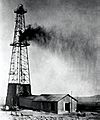Saudi Aramco facts for kids
 |
|
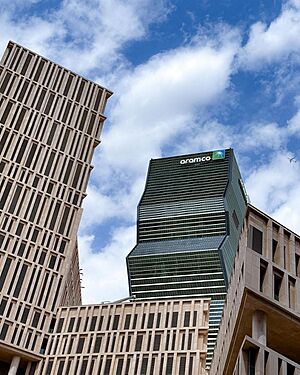
|
|
|
Trade name
|
Saudi Aramco |
|---|---|
|
Native name
|
Saudi Arabian Oil Company
|
| Public (mostly state-owned) | |
| Traded as | Tadawul: 2222 |
| Industry | Oil and gas |
| Founded | 29 May 1933 (as California-Arabian Standard Oil) |
| Headquarters | Dhahran, Saudi Arabia |
|
Area served
|
Worldwide |
|
Key people
|
|
| Products | |
| Revenue | |
|
Operating income
|
|
| Total assets | |
| Total equity | |
| Owner | Government of Saudi Arabia (82.19%) Public Investment Fund (12%) Sanabil (4%) |
|
Number of employees
|
75,000+ (2024) |
| Subsidiaries | SABIC (70%), Petro Rabigh, SATORP, Aramco Trading, Yanbu, Yasref, SASREF, S-Oil, Luberef, Aro Drilling, South Rub al-Khali, Pengerang Refining Company, The International Maritime Industries |
Saudi Aramco (Arabic: أرامكو السعودية ʾArāmkū as-Suʿūdiyyah), also known as Aramco, is a huge oil and natural gas company. It is mostly owned by the government of Saudi Arabia. As of 2024, it was the fourth-largest company in the world based on how much money it made. Its main office is in Dhahran, Saudi Arabia.
Saudi Aramco has the world's second-largest proven crude oil reserves. It also produces more oil each day than any other oil company. The company runs the world's largest network for moving oil and gas, called the Master Gas System. In 2024, it produced 12.7 million barrels of oil equivalent every day. It manages over 100 oil and gas fields in Saudi Arabia. This includes the Ghawar Field, which is the world's largest oil field on land. It also manages the Safaniya Field, the world's largest oil field in the sea.
On December 11, 2019, Saudi Aramco's shares started being traded on the Saudi Exchange. The shares quickly rose, making the company worth about US$1.88 trillion. On its second day of trading, its value went over US$2 trillion.
Contents
History of Saudi Aramco
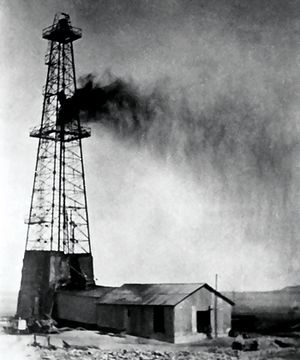
Saudi Aramco's story began because there wasn't enough oil during World War I. American companies wanted to find new oil sources outside the United States. The Saudi Arabian government gave a company called Standard Oil of California (SoCal) the right to look for oil in Saudi Arabia. SoCal created a new company for this, called California-Arabian Standard Oil (CASOC).
For a few years, they didn't find any oil. In 1936, another company, Texaco, bought half of CASOC. After four more years of searching, they finally found oil in 1938. This happened at the seventh drill site in Dhahran, which was named Dammam No. 7. This well immediately produced a lot of oil, which made the company confident to keep going.
On January 31, 1944, the company's name changed to Arabian American Oil Co., or Aramco. Later, in 1948, other big oil companies like Standard Oil of New Jersey (Exxon) and Socony Vacuum (Mobil) also bought parts of Aramco.
In 1950, King Abdulaziz of Saudi Arabia wanted to take control of the oil facilities in his country. This led Aramco to agree to share its profits equally with the Saudi government. After this agreement, Aramco moved its main office from New York to Dhahran, Saudi Arabia. In 1951, Aramco found the Safaniya Oil Field, which is the world's largest offshore oil field. In 1957, they confirmed that the Ghawar Field was the world's largest oil field on land.
In 1975, Saudi Arabia started a plan to use natural gas to create power instead of burning it off. This plan helped Aramco use more natural gas from its fields.
Government Takes More Control
In 1973, after the Yom Kippur War, the Saudi Arabian government bought 25% of Aramco. In 1974, they increased their ownership to 60%. Aramco continued to manage the oil fields for the Saudi government until 1988. In November 1988, a special order created a new Saudi company, the Saudi Arabian Oil Company (Saudi Aramco). This new company took full control of Saudi Arabia's oil and gas fields.
Persian Gulf War and Growth
In September 1990, when the Persian Gulf War began, Aramco had to produce much more oil. This was because oil production from Iraq and Kuwait was stopped. Aramco increased its daily production from 5.4 million barrels to 8.5 million barrels in just three months. They also provided all the fuel needed by the countries fighting in the war.
Starting in 1990, Aramco began selling more crude oil to countries in Asia. By 2016, about 70% of Aramco's crude oil sales went to Asia.
New Discoveries and Investments
In the early 2000s, Saudi Arabia started a plan to explore for more natural gas. Aramco worked with other international oil companies on these projects. By 2004, Aramco was producing 8.6 million barrels of oil per day. In 2005, Aramco planned to spend US$50 billion to increase its daily oil production capacity to 12.5 million barrels. In 2005, Saudi Aramco was the world's largest company, valued at about US$781 billion.
In 2011, Saudi Aramco started producing natural gas from the Karan Gas Field. In 2016, Saudi Arabia's Deputy Crown Prince, Mohammad bin Salman Al Saud, thought about selling a small part of the company's shares to the public.
In June 2019, Yasir Al-Rumayyan became the Chairman of Aramco.
Cyber Attack in 2012
On August 15, 2012, Aramco's computers were attacked by a computer virus. The company quickly announced that the infected computers were not connected to the oil production network. They were able to get their systems working fully again soon after. A group of hackers claimed responsibility for spreading the virus, which affected about 30,000 Aramco computers. The virus, called Shamoon, could erase files and make computers unusable.
Drone Attack in 2019
On September 14, 2019, drones attacked two Saudi Aramco facilities: the Abqaiq oil processing plant and the Khurais oil field. Houthi rebels said they were responsible for the attack. This attack cut Saudi Arabia's crude oil production by 5.7 million barrels per day, which was over 5% of the world's oil supply.
Initial Public Offering (IPO)
For a few years, Saudi Arabia thought about selling a small part of Saudi Aramco's ownership to the public. This would be done through an initial public offering (IPO). The goal was to raise money for the government. The drone attacks in September 2019 caused a delay in the IPO plans.
On April 9, 2019, Aramco sold bonds worth US$12 billion. This was a huge success, with over US$100 billion in orders from investors. On November 3, 2019, Aramco announced its plan to sell 1.5% of its value as an IPO on the Tadawul stock exchange.
On December 4, 2019, Saudi Aramco set its share price at 32 Saudi riyals (about US$8.53). The company received orders for shares worth US$119 billion. It raised US$25.6 billion in its IPO, making it the largest IPO in the world at that time. When trading began on December 11, 2019, shares rose by 10%. This made Saudi Aramco the world's largest listed company, with a market value of about US$1.88 trillion.
Recent Developments
In March 2020, Saudi Aramco announced a partnership with Formula One. In June 2020, Saudi Aramco bought 70% of SABIC, a company that makes chemicals. Also in June 2020, Aramco let go of about 500 employees, mostly foreigners, because of the COVID-19 pandemic affecting oil demand. On July 31, 2020, Apple became the world's largest listed company by market value, passing Saudi Aramco.
In March 2021, Aramco reported that its earnings in 2020 dropped by almost 45% because the COVID-19 pandemic reduced the demand for oil. On March 19, 2021, a drone attack, claimed by Houthi rebels, caused a fire at an Aramco refinery. No one was hurt, and there was no major damage. On March 21, 2021, Saudi Aramco signed a deal with China to provide energy for the next 50 years and work on new technologies to fight climate change.
In October 2021, Saudi Aramco announced a goal to have net-zero carbon emissions from its own operations by 2060. In 2021, Aramco also said it planned to increase its crude oil production capacity from 12 million barrels a day to 13 million barrels by 2027.
In February 2022, Aramco increased oil prices for its customers in Asia, the United States, and Europe. In March 2022, Houthi fighters attacked an Aramco storage site in Jeddah, causing a fire. On May 11, 2022, Saudi Aramco became the most valuable company in the world again, passing Apple Inc.. In August 2022, Saudi Aramco announced it would buy Valvoline's petroleum unit for $2.65 billion.
In March 2023, Saudi Aramco announced record profits of $161 billion. This was due to high oil prices after the COVID-19 pandemic. In the same month, Aramco said it would buy a 10% share in China's Rongsheng Petrochemical Co. Ltd. for about $3.6 billion. They also planned to build a new refining and petrochemical complex in China.
In September 2023, Saudi Aramco agreed to buy Esmax Distribución SPA, a fuel retailer in Chile. This move marked Aramco's entry into the fuel retail market in South America. Starting in May 2024, the 300 Petrobras service stations in Chile began to gradually change to Aramco service stations. In December 2023, Saudi Aramco bought 40% of Gas & Oil Pakistan.
How Saudi Aramco Works
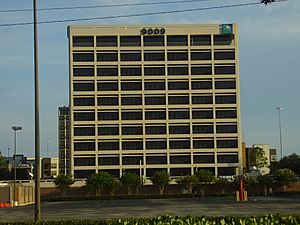
Saudi Aramco's main office is in Dhahran, Saudi Arabia. But its work happens all over the world. This includes finding oil and gas, producing it, refining it, making chemicals, and distributing and selling products. The Saudi Arabian Ministry of Petroleum and Mineral Resources watches over all these activities.
Company Finances
Here's a look at Saudi Aramco's financial performance over the years (ending December 31):
| Revenue (USD million) |
Income before tax (USD million) |
Net Income (USD million) |
Total Assets (USD million) |
|
|---|---|---|---|---|
| 2017 | 264,176 | 155,050 | 75,898 | 294,014 |
| 2018 | 359,204 | 212,772 | 111,071 | 359,171 |
| 2019 | 329,809 | 177,798 | 88,185 | 289,581 |
| 2020 | 229,891 | 99,313 | 49,003 | 404,102 |
| 2021 | 400,468 | 205,206 | 109,972 | 576,718 |
| 2022 | 604,366 | 307,456 | 161,068 | 664,780 |
| 2023 | 495,033 | 236,818 | 121,271 | 660,784 |
| 2024 | 480,446 | 208,536 | 106,246 | 646,301 |
Finding Oil and Gas
Many geophysicists and geologists work for Saudi Aramco. They have been looking for oil and gas since 1982. They use powerful computers to help them process the huge amounts of data they collect during exploration.
Refining and Chemicals
Saudi Aramco also refines oil and makes chemicals. In 1993, the Saudi government merged Aramco with the country's oil refining company, Samarec. This made Aramco responsible for refining and distributing oil in Saudi Arabia.
Currently, Saudi Aramco can refine about 5.4 million barrels of oil per day. The company is also focusing on combining its refineries with chemical plants. One example is Petro Rabigh, a joint project with Sumitomo Chemical Co.
Refineries in Saudi Arabia

Here are some of the refineries Aramco operates in Saudi Arabia:
- Jazan Refinery and terminal projects (JRTP) (400,000 barrels per day)
- Ras Tanura Refinery (550,000 barrels per day)
- The Saudi Aramco Jubail Refinery Co. (SASREF), Jubail (305,000 barrels per day)
- Riyadh Refinery (126,000 barrels per day)
- Yanbu Refinery (245,000 barrels per day)
Aramco also has joint refining projects with other companies in Saudi Arabia and around the world.
Shipping Oil and Gas
Saudi Aramco uses many tankers to ship crude oil, refined oil, and natural gas to different countries. It used to have its own shipping company, Vela International Marine, which later joined with the Bahri company. Aramco is also involved in building the King Salman Global Maritime Industries Complex, which will be one of the largest shipyards in the world.
Global Investments
Saudi Aramco has grown its presence in major energy markets around the world, including Asia, Europe, and North America. In April 2019, Aramco bought a 13% share in the South Korean oil refiner Hyundai Oilbank. Also in April 2019, Aramco signed a deal to supply crude oil to Poland’s main oil refiner, PKN Orlen.
Liquefied Natural Gas (LNG)
Aramco plans to become a major producer of LNG. It has already sold its first cargo of LNG from Singapore to a buyer in India. The company is looking for partnerships globally to reach its goal in the LNG market.
Saudization: Training Saudi Workers
From the very beginning, Aramco had a rule to hire and train Saudi nationals as much as possible. This was a very important part of shaping Saudi society. The company started its first school in 1940 to educate its Saudi employees. By 1950, Aramco had built schools for 2,400 students. In 1959, Aramco sent the first group of Saudi students to college in the United States.
Over the years, more and more Saudis took on important roles in the company. In 1965, Zafer H. Husseini became the first Saudi manager. In 1983, Ali Al-Naimi became the first Saudi president of Aramco. By 1987, nearly two-thirds of Aramco's 43,500 employees were Saudis. This effort to train and promote Saudi workers is called "Saudization."
Environmental Impact
Environmental groups say that Saudi Aramco is responsible for more than 4% of global greenhouse gas emissions since 1965. Most of these emissions come from people using the oil Aramco sells, like burning gasoline in car engines. Aramco does not have a plan to limit these "scope 3" emissions, which are from the use of its products. However, the Saudi government says it will have net zero carbon emissions within the country by 2060.
In October 2023, Saudi Aramco announced a project to capture carbon directly from the air. This project is being done with Siemens Energy and was completed in 2024. On December 9, 2024, Aramco, along with SLB and Linde, signed an agreement to build a carbon capture and storage project in Jubail, Saudi Arabia. Aramco will own 60% of this project. The first part of this project is expected to be finished by the end of 2027. It aims to capture and store up to 9 million metric tons of carbon dioxide each year.
Research and Lobbying
Saudi Aramco has supported many studies on energy issues. It has also worked with the United States Department of Energy on projects to improve oil production. Since 2016, Saudi Arabia has spent money to influence public opinion and policies in the US. Aramco is also working on new technologies, like a device that could trap some carbon dioxide from cars that run on gasoline. Saudi Aramco has partnered with Hyundai to develop a special fuel for gas-electric vehicles.
Images for kids
-
Dammam No. 7 struck oil in 1938, becoming the first commercial oil well in Saudi Arabia.
-
The main office of Aramco Services Co. in Houston, USA.
-
The Riyadh oil refinery, run by Aramco, is located near Riyadh.
See also
 In Spanish: Saudi Aramco para niños
In Spanish: Saudi Aramco para niños


